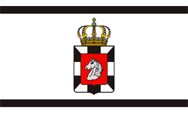Sachsen-Lauenburg |
|
|
|
| Übersicht – Contents: | |
Sachsen-Lauenburg |
|
|
|
| Übersicht – Contents: | |
Flaggen – Flags: |
|
 |
1296–1689, Landesfarben Herzogtum Sachsen-Lauenburg – colours of the Duchy of Saxony-Lauenburg, Quelle/Source: nach/by: World Statesmen |
 |
1867–1876, Flagge des Preußischen Herzogtums Lauenburg – flag of the Prussian Duchy of Lauenburg, Quelle/Source: nach/by: Flags of the World |
|
|
|
Bedeutung/Ursprung der Flagge – Meaning/Origin of the Flag: |
|
| Die Farben des Herzogtums Sachsen-Lauenburg waren Schwarz und Gold. Die Farben sind dem Sächsischen Schild entnommen. | The colors of the Duchy of Saxony-Lauenburg were black and gold. The colors were taken from the Saxon coat of arms. |
| Nach dem Aussterben der Askanier in Lauenburg wurde das Herzogtum Lauenburg in Personalunion mit dem Kurfürstentum Braunschweig-Lüneburg verbunden. Es ist keine eigene Flagge überliefert. | After the extinction of the Ascanians in Lauenburg, the Duchy of Lauenburg was connected in personal union with the Electorate of Brunswick-Lueneburg. An own flag is not known in that time. |
| Als das Herzogtum 1816 in Personalunion an die dänischen Könige kam, wurde wahrscheinlich keine eigene Flagge verwendet, statt dessen wohl die dänische Flagge. | When the duchy in 1816 was connected in personal union with the Danish kings, an own flag was probably not in use, instead of it probaly the Danish flag. |
| Zwei Jahre nachdem Lauenburg ein preußisches Herzogtum geworden war, erhielt es eine eigene Flagge. Diese kombinierte mit Schwarz und Weiß die Farben von Preußen in einer weißen Flagge mit zwei schmalen schwarzen Streifen in der Nähe des oberen und unteren Randes der Flagge. In der Mitte das neu geschaffene Wappen mit der preußischen Königskrone. | Two years
after Lauenburg became a Prussian duchy, it became awarded its own flag.
This flag combined with black and white the colors of Prussia, in a white
flag with two narrow black stripes near the top and bottom edges of the
flag. In the middle appeared the newly created coat of arms with the crown
of the Prussian kings. |
| Quelle/Source: Flags of the World, World Statesmen | |
Wappen – Coat of Arms: |
|
 |
1180–1296, Wappen Herzogtum Sachsen – coat of arms of the Duchy of Saxony, Quelle/Source: nach/by: Wikipedia (D) |
 |
1296–1689, Wappen Herzogtum Sachsen-Lauenburg – coat of arms of the Duchy of Saxony-Lauenburg, Quelle/Source: nach/by: Wikipedia (D) |
 |
1815–1864, Wappen Dänisches Herzogtum Lauenburg – coat of arms of the Danish Duchy of Lauenburg, Quelle/Source: nach/by: Heraldique Europeenne |
 |
1867–1876, Wappen Preußisches Herzogtum Lauenburg – coat of arms of the Prussian Duchy of Lauenburg, Quelle/Source: nach/by: Flags of the World |
|
|
|
| Bedeutung/Ursprung des Wappens – Meaning/Origin of the Coat of Arms: | |
| Als die Würde des Herzogs von Sachsen im Jahre 1180 von den Welfen auf die Askanier überging, spekulierten diese eigentlich auf das ganze Herzogtum Sachsen, erhielten jedoch nur Ostfalen. Westfalen und Engern waren vom Kaiser abtrennt worden. Die Askanier beanspruchten diese Territorien unentwegt durch alle Zeiten. Das widerspiegelt sich auch Wappen des askanischen Herzogtums Sachsen-Lauenburg. Es ist viergeteilt und zeigt im ersten und vierten Feld die Heraldik des Herzogtums Sachsen, im zweiten Feld der Pfalzgrafschaft Sachsen und im dritten Feld des Herzogtums Engern. | When the dignity of the Duke of Saxony in 1180 passed from the Guelphs to the Ascanians, these actually speculated on the whole Duchy of Saxony, but they received only Eastphalia. Westphalia and Engern had been separated by the emperor. The Ascanians claimed these territories unswervingly and on throughout the ages. That is also reflected in the coat of arms of the Ascanian Duchy of Saxe-Lauenburg. It is divided into four sections and shows in the first and in the fourth field the heraldry of the Duchy of Saxony, in the second field of the Palatinate of Saxony and in the third field of the Duchy of Engern. |
| Das Wappen des Herzogtums Sachsen, das heute noch das Wappen des Freistaats Sachsen ist, wurde um 1180 geschaffen, als die Askanier, Markgrafen von Brandenburg und Grafen von Ballenstedt zu den Herzögen von Sachsen wurden: Über das Ballenstedter Wappen wurde ein grüner Rautenkranz gelegt. | The coat of arms of the Duchy of Saxony, which is until today the emblem of the Free State of Saxony, was created about 1180, as the Ascanians, Margraves of Brandenburg and Counts of Ballenstedt became to the Dukes of Saxony: over the coat of arms of Ballenstedt was placed a green diamond wreath. |
| Nach dem Aussterben der Askanier in Lauenburg wurde das Herzogtum Lauenburg in Personalunion mit dem Kurfürstentum Braunschweig-Lüneburg verbunden, was in dessen Wappen ohne Folgen blieb. Wahrscheinlich ist kein neues Wappen geschaffen worden. | After the extinction of the Ascanians in Lauenburg the Duchy of Lauenburg was connected in personal union with the Electorate of Brunswick-Lueneburg, what causes no consequences in its coat of arms. Probably a new coat of arms has been not created. |
| Als das Herzogtum 1816 in Personalunion an die dänischen Könige kam, erschien es mit einem goldenen Pferdekopf auf rotem Grund im dänischen Wappen. Der Pferdekopf ist eine Anspielung auf das Sachsenross der Welfen. | When the duchy in 1816 was connected in personal union with the Danish kings, it appeared by a golden horse's head on a red background in the Danish arms. The horse's head is an allusion to the Sxon Steed of the Guelph. |
| Das wurde in der Zeit als preußisches Herzogtum beibehalten, jedoch war der Pferdekopf silbern, und der rote Schild lag als Herzschild auf einem in Silber und Schwarz gestecktem Wappenschild. Schwarz und Weiß sind die Farben von Preußen. Auf dem Schild die preußische Königskrone. | That was maintained in time as Prussian Duchy, but the horse's head was silvery, and the red shield was a central shield on an escutcheon coloured in silver and black. Black and white are the colors of Prussia. On the shield appears the crown of the Prussian kings. |
| Quelle/Source: Wikipedia (D), Flags of the World, Heraldique Europeenne | |
Landkarten – Maps: |
|
|
|
| Die Landkarte zeigt das Herzogtum Sachsen-Lauenburg in etwa im Jahre 1400, in roter Umrandung. | The map shows the Duchy of Saxony-Lauenburg in about the year 1400, within a red border. |
|
|
| Die Landkarte zeigt das Herzogtum Sachsen-Lauenburg in etwa im Jahre 1400, in roter Umrandung. Die Innerhalb gelegenen farbig umrandeten Gebiete gingen ab 1420 an Hamburg (orange) und Lübeck (Gelb) verloren. Besonders Lübecker Besitz konnte bis zum Ende des 18. Jahrhunderts wieder zurückgewonnen werden. Als das Land, das ab 1689 zu Braunschweig-Lüneburg (Hannover) gehörte, 1815 ein Dänisches Herzogtum wurde, verblieben nur die südlichen Gebiete (Amt Neuhaus und Elbmarsch) bei Hannover. Der Norden wurde 1865 ein preußisches Herzogtum. | The map shows the Duchy of Saxony-Lauenburg in about the year 1400, within a red border. The inside placed outline-colored areas got lost from 1420 to Hamburg (orange) and Lubeck (yellow). Especially the Lubeck possessions returned back to Lauenburg to the end of the 18th century. As the country – which belonged from 1689 to Brunswick-Lueneburg (Hanover) – became in 1815 a Danish duchy, remained only the southern regions (Amt Neuhaus and Elbmarsch) in Hanover. The North became in 1865 a Prussian duchy. |
Zahlen und Fakten – Numbers and Facts: |
|
|
|
|
|
|
|
|
|
|
|
|
|
|
|
Geschichte: |
| Die
Geschichte Sachsens beginnt mit dem alten Stammesherzogtum Sachsen im
heutigen Nordwestdeutschland im 5. Jahrhundert. In den Sachsenkriegen Karls
des Großen (772–804) wurde es besiegt und dem Frankenreich einverleibt,
blieb jedoch als Herzogtum erhalten. Bedeutende Herzöge waren die Welfen,
bekannt durch ihren Widerstand gegen die staufischen Kaiser, die 1180 in der
Zerschlagung des Herzogtums durch den Kaiser endete. Der Titel des Herzogs
von Sachsen blieb erhalten, wurde jedoch mit Randgebieten des alten
Herzogtums verbunden, mit Teilen von Ostfalen an der mittleren Elbe, und
einigen Gebiete an der Unterelbe: Lauenburg und Hadeln. Das Herzogtum
Sachsen-Lauenburg entstand mit der Erbteilung des Herzogtums im Jahre 1296
und endete de facto im Jahre 1689 mit dem Tod des letzten Herzogs aus dem
Hause der Askanier.
400
· die Region Lauenburg ist Siedlungsgebiet der Sachsen |
History: |
| The
history of Saxony begins with the ancient tribal Duchy of Saxony in today's
northwestern Germany in the 5th century. In the Saxon Wars of Charlemagne
(772–804), it was conquered and became annexed by the Franks, but it
remained, however, as a duchy. Important dukes have been the dukes from the
Welf Dynasty (Guelph), known for her opposition to the Hohenstaufen
emperors, which ended in 1180 in the desintegration of the duchy by the
emperor. The title of the Duke of Saxony remained, but was associated with
peripheral regions of the ancient duchy with parts of Eastphalia on the
middle of Elbe River, and some areas on the lower Elbe: Lauenburg and
Hadeln. The Duchy of Saxe-Lauenburg came into beeing with the inheritance of
the duchy in 1296 and ended de facto in 1689 with the death of the last duke
of the house of Ascanians. 400 · the Saxons settle in the Lauenburg
region |
| Quelle/Source: Wikipedia (D), Historisches Deutschland, Atlas zur Geschichte, Herders Conversations-Lexikon |
Ursprung des Landesnamens – Origin of the Country's Name: |
|
| Der alte Name "Lauenburg" würde heute "Löwenburg" heißen. | The old name "Lauenburg" would today be called "Lion's Burg" (Lion's Castle). |
| Quelle/Source: Handbuch der geographischen Namen | |